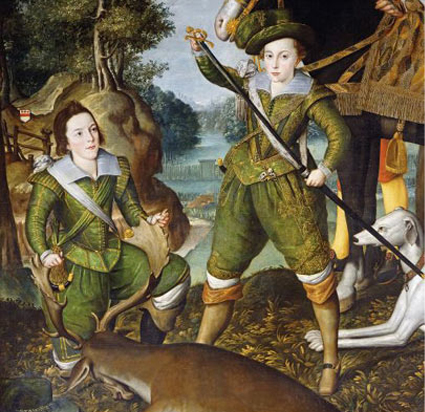“The Lost Prince”, at The National Portrait Gallery.
In around 1605 Robert Peake, Serjeant-Painter to the royal household, painted an elaborate portrait of the boy whom he supposed to be the future King of England. Prince Henry Frederick Stuart, eleven years old, is shown at the climactic moment of a deer hunt. He stares out with an expression of imperturbable self-confidence, his feet firmly planted on a patch of carpet-soft greensward, drawing a sword nearly as long as he is tall from its gold-tipped scabbard. At the feet of the whey-faced youth lies a dead stag. The heir apparent is about to test the quality of the venison with the point of his weapon, an ancient custom of the hunt. At his side, gripping the deer’s gnarly horns, kneels fresh-faced young Robert Devereux, son of the disgraced and executed 2nd Earl of Essex, former favourite of Elizabeth I. The courtly ritual is observed by Henry’s sweetly staring horse and his attentive hound, each painted in profile like a heraldic device. Behind the young prince a fertile vision of England recedes into a misty green distance, where towers cluster on a distant hilltop and a gothic spire is silhouetted against the sky. Church and state: one day, all this will be his.
“The Lost Prince”, at the National Portrait Gallery, is a fascinating what-if of an exhibition. Its subject is the king who never was: son and heir to James VI of Scotland and I of England; ill-fated elder brother of Charles, the weak-willed boy who would become king in his place and eventually lead England into the turmoil of the Civil War. What course might history have taken had Henry, Prince of Wales, survived beyond his nineteenth year? How might England have fared under Henry IX, rather than Charles I?...


